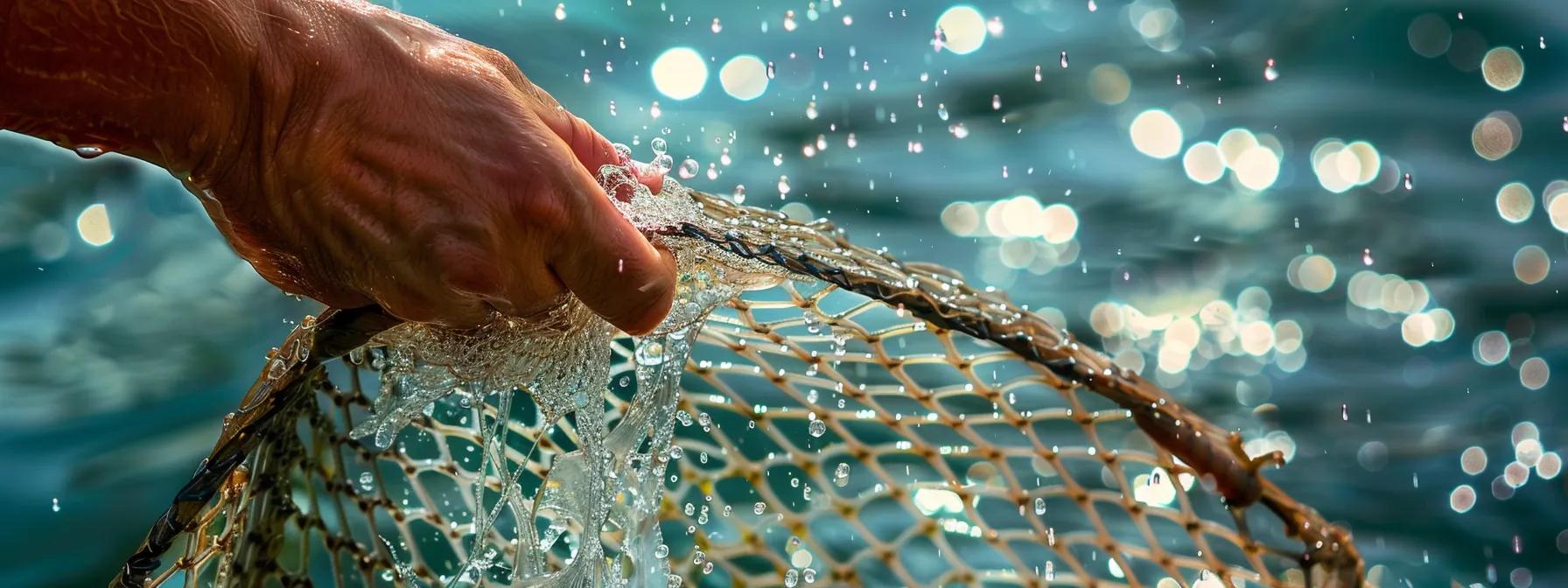Choosing the right mesh size for your fishing net can make a significant difference in your fishing success. Many anglers overlook this important aspect, leading to missed catches and wasted time. In this comprehensive guide, you will learn about the various factors that influence mesh size, how to select the right one based on your fishing goals, and tips for testing options in your fishing nets collection. By understanding the nuances of mesh size, such as those found in Rising Fishing’s Rasta Cerakote nets or cerakote boat nets, you’ll be equipped to enhance your fishing recreation experience and solve common challenges on your next trip.
Understanding Mesh Size and Its Importance for Fishing Nets

Mesh size is crucial in fishing nets collection as it directly influences your catch efficiency. Understanding how to define mesh size will help you choose a net that meets your angling needs. Various sizes have unique applications, which we will explore, focusing on common measurements like vine and button styles, along with their effectiveness at insulating or sinking your catch. Pay attention to how perimeter dimensions impact your experience, and you'll gain practical insights into optimizing your gear preferences for your fishing recreation. Let’s dive into what each mesh size can do for you and your fishing adventures.
Defining Mesh Size in Fishing Nets
When it comes to defining mesh size in fishing nets, it refers to the dimensions of the openings created by the knotting of the material, often nylon. Each mesh size is tailored to catch specific species effectively while allowing optimal airflow, ensuring that your catch remains fresh for your fishing recreation. Understanding these sizes will aid you in selecting the right net from our fishing nets collection, whether you're targeting larger game fish or smaller species, ensuring your gear suits your fishing style perfectly.
How Mesh Size Affects Catch Efficiency
The mesh size of your fishing net plays a critical role in determining your catch efficiency. A smaller mesh size can capture tiny fish or bait, while a larger mesh allows for the capture of bigger game fish without losing them through the openings. When you choose the right mesh size, you enhance your ability to maximize your catch while minimizing the need for adjustments during installation, ensuring that your fishing recreation meets your expectations and enhances your fishing nets collection.
- Understand the relationship between mesh size and species targeting.
- Consider how different mesh dimensions impact water flow and catch survival.
- Evaluate how your radius of use may dictate the preferred mesh style.
- Be mindful of the materials used in construction, such as steel, for durability.
Common Mesh Sizes and Their Uses
When selecting a fishing net from your fishing nets collection, understanding common mesh sizes is vital for optimizing your catch. For instance, a net with a small mesh size, typically measuring around one inch, is ideal for capturing smaller species or bait fish, while a larger mesh size, such as four inches, is suitable for targeting bigger game fish like bass. The materials used, such as polyester for durability or wire rope for added strength, also play a significant role in the net's overall performance and longevity, making it important to consider how each component affects your fishing experience for fishing recreation.
- Identify the appropriate mesh size based on your target species.
- Select materials like polyester or wire rope for enhanced durability.
- Balance mesh size with the pound of catch expected to optimize efficiency.
Now that you grasp the significance of mesh size in our fishing nets collection, consider the factors that shape your choice. Each decision impacts your catch and the fishing recreation on the water, making it worth your while to pay attention.
Factors Influencing Your Choice of Mesh Size

Choosing the right mesh size for your fishing net collection hinges on several key factors. First, consider the target species and their sizes, as different fish may require varied mesh dimensions. Next, reflect on the fishing techniques and rising fishing methodologies you employ, which can affect mesh effectiveness. Additionally, environmental conditions and water types play a crucial role, potentially influencing the elasticity of your tackle. Understanding these elements will help ensure your fishing recreation trips are successful.
Target Species and Their Sizes
Understanding the sizes of your target species is fundamental when selecting the right mesh size for your fishing net. Smaller species, like bait fish, require finer mesh made from durable twine to prevent them from escaping, while larger game fish need wider openings to accommodate their weight and dimensions. Choosing appropriate mesh size not only enhances your catch efficiency but also minimizes the chance of collecting unwanted debris, ensuring your fishing experiences remain focused on your desired cargo. This precision is crucial for effective fishing nets collection and supports engaging in fishing recreation.
Fishing Techniques and Methodologies
The fishing techniques and methodologies you use directly impact the choice of mesh size for your net. If you're utilizing a cast net for catching bait, a finer mesh is essential to prevent smaller fish from escaping while ensuring your gear remains effective. Additionally, understanding the specific requirements for pest control in your fishing recreation area can also influence your decision, as different environments may necessitate different mesh configurations to optimize your catch. Always check for warranty details when selecting your fishing nets collection gear, as this can provide assurance regarding the durability of your net against various fishing techniques.
Environmental Conditions and Water Type
Environmental conditions and water type significantly influence your choice of mesh size for fishing nets collection. For instance, if you’re casting in shallow waters with a strong current, a finer mesh can enhance your harvest success by ensuring that smaller fish don't slip through your net. Conversely, in more still or deeper waters, you might opt for a larger mesh to capture heavier game fish, taking into account how metal components in your gear can provide durability against wear and tear. Remember to consider how different types of bird netting or fencings might impact how your net performs in various habitats, ensuring you’re well-equipped to meet your angling goals for fishing recreation.
Choosing the right mesh size affects your catch, but the net's materials play an equally crucial role. Understanding these elements will ensure you have the right tools for every fishing trip.
Materials and Construction of Fishing Nets

When selecting your fishing net from a fishing nets collection, understanding the various types of netting materials is essential. You will examine how materials like polymer, polypropylene, and polyethylene impact mesh size performance and catch efficiency. Additionally, considering factors like wear and maintenance will ensure your gear remains reliable during your fishing recreation. These insights will empower you to make informed choices about your net's construction.
Comparing Different Types of Netting Materials
When selecting netting materials for fishing, understanding the characteristics of different fibers is essential for your success. For instance, nylon offers excellent strength and durability, making it a favorite for anglers targeting larger game fish, while polyethylene is lightweight and can enhance visibility, which is beneficial for catching bait fish. Enhance your fishing nets collection by considering the length and stretch of the fibers, as these factors influence how well the net performs under various conditions, ensuring that you achieve efficient catches and maintain a reliable setup during your fishing recreation adventures.
How Material Affects Mesh Size Performance
The choice of material significantly impacts the performance of your fishing net regarding mesh size. For example, using plastic nets may offer lightweight convenience for fishing recreation, which can be beneficial when targeting fly or shrimp, as they provide a gentle approach to catching smaller species without causing harm. Conversely, more durable materials like nylon enhance your net’s resilience and strength, making it ideal for capturing larger catches and expanding your fishing nets collection while maintaining the integrity of the mesh size, ensuring that your fishing experiences are both effective and efficient.
Durability and Maintenance Considerations
When selecting a fishing net from your fishing nets collection, it's essential to consider durability and maintenance to ensure it meets the demands of your fishing adventures and fishing recreation. A net made from sturdy materials like stainless steel or a cerakote boat net can withstand harsh conditions and the weight of large catches, especially if you're into commercial fishing. Additionally, taking care to choose the right mesh size, typically around one inch in diameter, can lessen wear and tear, prolonging its lifespan while enhancing your overall fishing experience.
The material and construction of your fishing net lay the groundwork for success. Next, understanding how to select the right mesh size will sharpen your approach and enhance your catch.
Selecting the Right Mesh Size Based on Fishing Goals
When choosing the right mesh size for your fishing net, consider your goals as an angler. For fishing recreation enthusiasts, selecting the appropriate mesh can enhance your catch while allowing the escape of unwanted species. Commercial fishermen might seek heavier-duty options like cerakote boat net or rasta cerakote nets that withstand ultraviolet rays and larger catches. Lastly, incorporating fishing nets collection and sustainability practices ensures responsible fishing that protects aquatic ecosystems.
For Recreational Fishing Enthusiasts
For recreational fishing enthusiasts, selecting the right mesh size is essential for an enjoyable outing on the water. A mesh size of about one inch is often ideal for capturing smaller species while allowing larger ones to escape harmlessly, helping you maintain a sustainable fishing approach. By understanding the fish species you aim to catch and choosing appropriate mesh sizes, you can enhance your overall fishing experience and increase your chances of a successful day on the water.
For Commercial Fishermen
For commercial fishermen, selecting the right mesh size is essential to maximize your catch while minimizing unwanted bycatch. A larger mesh, typically around four inches or more, allows for the efficient harvesting of larger, commercially valuable species while preventing smaller or non-targeted fish from being caught. Investing in durable materials and ensuring your net complies with regional regulations will enhance your productivity and sustainability, contributing to a more responsible fishing operation.
For Conservation and Sustainability Practices
Incorporating conservation and sustainability practices is vital for responsible fishing, and selecting the right mesh size in your net can play a significant role. By choosing a mesh size that allows smaller, non-target species to escape, you help maintain the delicate balance of aquatic ecosystems. You should also consider local regulations that often dictate appropriate mesh sizes for different fisheries, ensuring your practices support both sustainable fishing and conservation efforts.
- Choose mesh sizes that prevent bycatch of non-target species.
- Adhere to local regulations for responsible fishing practices.
- Support aquatic ecosystems by allowing the escape of juvenile fish.
Choosing the right mesh size is vital, but some often miss the mark entirely. Let's address these common misconceptions about mesh size to steer clear of mistakes.
Common Misconceptions About Mesh Size
Many anglers hold misconceptions about mesh sizes that can impact their fishing effectiveness. Some believe that larger mesh sizes are always better for efficiency, while others have unclear views on smaller mesh's implications. Regulations surrounding mesh size also play a vital role in your selection process. This section will clarify these myths, provide insights into mesh sizes' real effects, and explain how rules influence your choices.
Debunking Myths About Larger Mesh Sizes
Many anglers mistakenly believe that larger mesh sizes are universally better because they allow for quicker catches and less resistance in the water. In reality, while larger mesh can be effective for certain species, it may also lead to missed opportunities with smaller fish that can slip through the gaps. By understanding the specific needs of your target species and matching them with the correct mesh size, you will enhance your overall catch efficiency and minimize frustration on your fishing trips.
Clarifying Truths About Smaller Mesh Sizes
Smaller mesh sizes are often underestimated, yet they serve an essential role in fish capture. They excel at preventing smaller, desirable species from escaping, ensuring you efficiently gather bait or catch. By understanding the specific needs of your target fish, you can appreciate how a fine mesh allows certain species to thrive while keeping your focus on collecting those you intend to keep:
- Smaller mesh captures bait fish effectively.
- Prevents missed opportunities with wanted species.
- Helps in maintaining a sustainable fishing practice.
The Impact of Regulations on Mesh Size Selection
Regulations surrounding mesh size selection are vital for ensuring responsible fishing practices and maintaining healthy fish populations. These rules often dictate the maximum and minimum mesh sizes permitted, tailored to local ecosystems and targeted species. As an angler, familiarizing yourself with these regulations not only helps you avoid penalties but also enables you to align your fishing methods with sustainable practices that support aquatic life:
- Understand local laws to avoid fines.
- Choose mesh sizes that comply with regulations.
- Support conservation by following guidelines.
Misunderstandings about mesh size can lead to poor choices. It’s time to turn those thoughts into action with practical tips for testing and selecting the right fit for your needs.
Practical Tips for Testing and Choosing Mesh Size

To ensure you select the right mesh size for your fishing net, start by testing its efficacy with various fish species you plan to target. Consulting with experienced fishermen can provide valuable insights into what works best in your area. Additionally, utilizing online resources and tools will offer guidance on optimal mesh dimensions, helping you make informed choices for a successful fishing experience.
How to Test Your Fishing Net for Efficacy
To test your fishing net for efficacy, begin by conducting practical trials in your local fishing environment. Cast the net into areas where you commonly find your target species, paying close attention to how well it captures fish of various sizes. This hands-on approach will not only provide insights into the effectiveness of the chosen mesh size but also allow you to make adjustments based on the specific conditions and species present, ensuring you maximize your catch efficiency during your fishing adventures.
Consulting With Experienced Fishermen
Consulting with experienced fishermen is an invaluable step in selecting the right mesh size for your fishing net. By tapping into their knowledge, you gain insights into local fishing conditions, specific species behavior, and effective mesh sizes that yield results. These seasoned anglers can share practical examples from their own experiences, helping you understand how mesh size can directly affect your catch efficiency and overall fishing success.
Utilizing Online Resources and Tools for Guidance
Utilizing online resources and tools can significantly enhance your understanding of mesh size and its applications in fishing nets. Websites dedicated to fishing forums, instructional videos, and manufacturer guides offer valuable insights into best practices for selecting the right mesh size based on the species you target and the fishing conditions you face. Engaging with experienced anglers through social media groups or online communities can also provide practical advice and real-world examples, helping you make informed choices that improve your overall fishing efficiency.
You've learned how to find the right mesh size for your needs. Now, let’s tackle some of the common questions anglers have about these tools.
Addressing Frequently Asked Questions
Choosing the right mesh size for your fishing net can raise several questions. What mesh size works best for different species? If you've selected the wrong size, how can you modify your net? Additionally, where can you find more resources for understanding mesh sizes? This section will provide clear answers to these inquiries, offering practical insights to enhance your fishing strategy.
What Mesh Size Works Best for Different Species?
Choosing the right mesh size is essential for targeting specific fish species effectively. For example, if you’re aiming to catch smaller bait fish, a mesh size of about one inch is ideal, as it prevents them from escaping while allowing larger fish to pass through unharmed. Conversely, for larger game fish like bass, a mesh size of four inches or more will help you efficiently secure your catch without losing smaller, unintended species, ensuring your fishing efforts are both productive and sustainable.
How Can I Modify My Net if the Mesh Size Is Incorrect?
If you find that the mesh size of your fishing net is incorrect after some trial runs, there are several options to consider for modification. One approach is to add additional knotting to tighten the mesh, which can be particularly effective for preventing smaller fish from slipping through while maintaining adequate size for your target species. Alternatively, if you have access to different nets or materials, you might create a custom solution by interweaving new netting sections that feature the desired mesh size, ensuring your gear better aligns with your fishing goals.
Resources for Additional Information on Mesh Sizes
For anyone looking to deepen their understanding of mesh sizes for fishing nets, several resources can prove invaluable. Online forums and fishing community websites are excellent places to gain insights from experienced anglers who share tips based on their personal fishing experiences. Additionally, manufacturer websites often provide detailed guides and specifications, allowing you to compare different mesh sizes and materials, helping you make informed choices that align with your fishing goals.
Conclusion
Choosing the right mesh size for your fishing net is vital to enhancing your catch efficiency and ensuring a successful outing. Understanding various mesh dimensions helps you target specific species effectively while minimizing unwanted bycatch. By considering factors like target species, fishing techniques, and environmental conditions, you position yourself for greater success on the water. Equip yourself with knowledge about mesh sizes, and you'll not only optimize your fishing experience but also contribute to sustainable practices that protect aquatic ecosystems.


